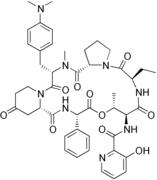Pristinamycin
| General | |||||||||||||
|---|---|---|---|---|---|---|---|---|---|---|---|---|---|
| Non-proprietary name | Pristinamycin | ||||||||||||
| other names |
RP 7293 |
||||||||||||
| Molecular formula | Mixture of substances | ||||||||||||
| External identifiers / databases | |||||||||||||
|
|||||||||||||
| Drug information | |||||||||||||
| ATC code | |||||||||||||
| Drug class | |||||||||||||
| properties | |||||||||||||
| Molar mass | Mixture of substances | ||||||||||||
| solubility |
slightly soluble in water; soluble in most organic solvents |
||||||||||||
| safety instructions | |||||||||||||
|
|||||||||||||
| As far as possible and customary, SI units are used. Unless otherwise noted, the data given apply to standard conditions . | |||||||||||||
Pristinamycin is an antibiotic drug . It is a mixture of substances obtained from cultures of Streptomyces pristinaespiralis or the same, produced in another way and is composed of the components pristinamycin I and II in a ratio of about 30:70.
The two main components have the following structure:
Pristinamycin is orally effective and is on the market in France for the treatment of superinfected chronic bronchitis , skin infections, acute pneumonia and sinusitis (trade name: Pyostacine ). The following are described as sensitive germs:
- Aerobic Gram-positive : Bacillus anthracis , Bacillus cereus , Corynebacterium , Enterococcus pneumonia
- Aerobic gram-negative : Bordetella pertussis , Haemophilus , Legionella , Moraxella catarrhalis , Neisseria
- Anaerobes: Actinomyces , Clostridium acnes
- Other: Chlamydia trachomatis , Chlamydia pneumoniae , Coxiella , Mycoplasma hominis , Mycoplasma pneumoniae , Ureaplasma urealyticum
Individual evidence
- ↑ Martindale: The Extra Pharmacopoeia (28th Edition). Edited by JEF Reynolds, 1982.
- ↑ a b caymanchem: Virginiamycin complex , accessed on September 22, 2018.
- ↑ Pristanimycin in Vidal.

